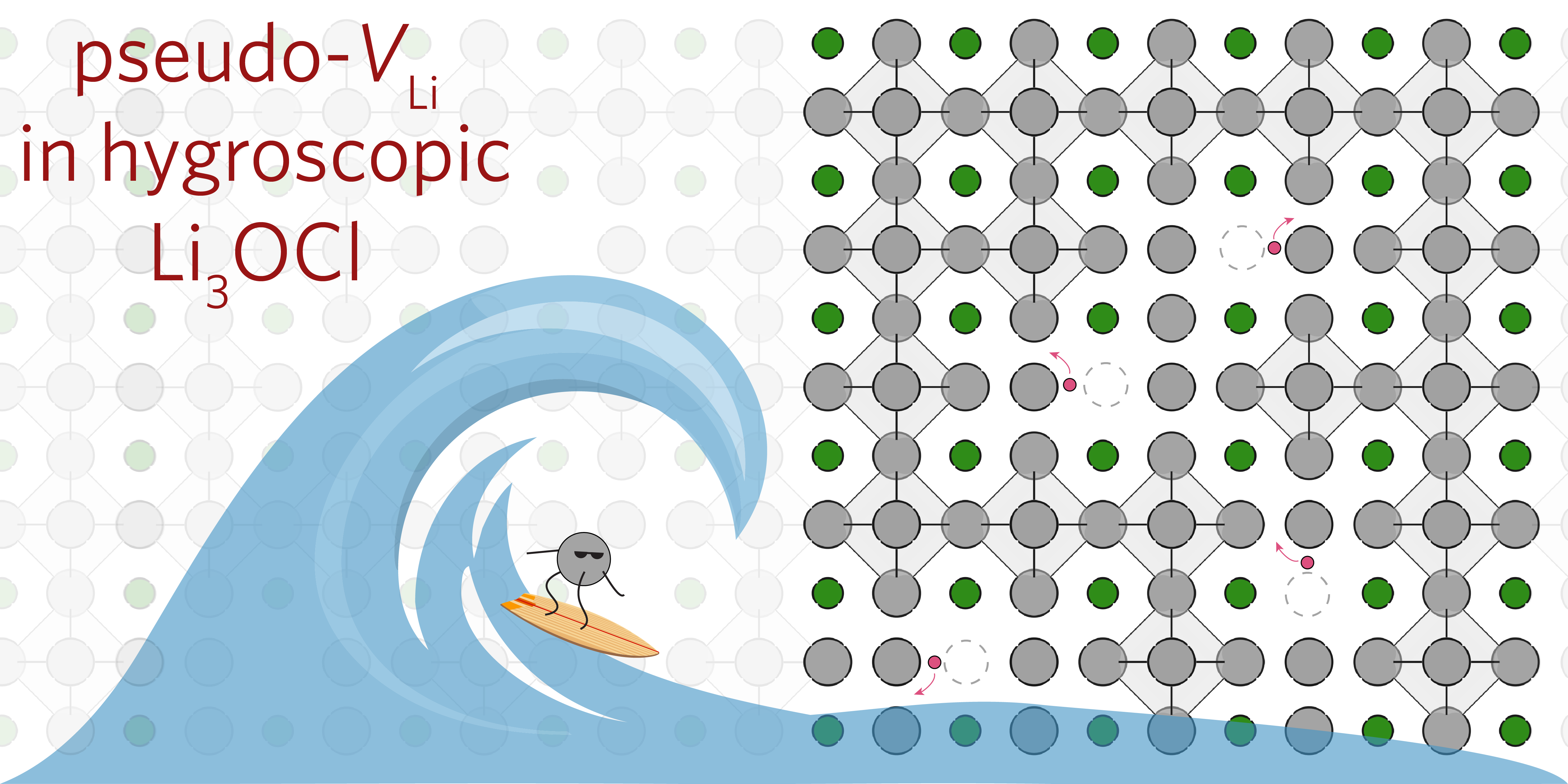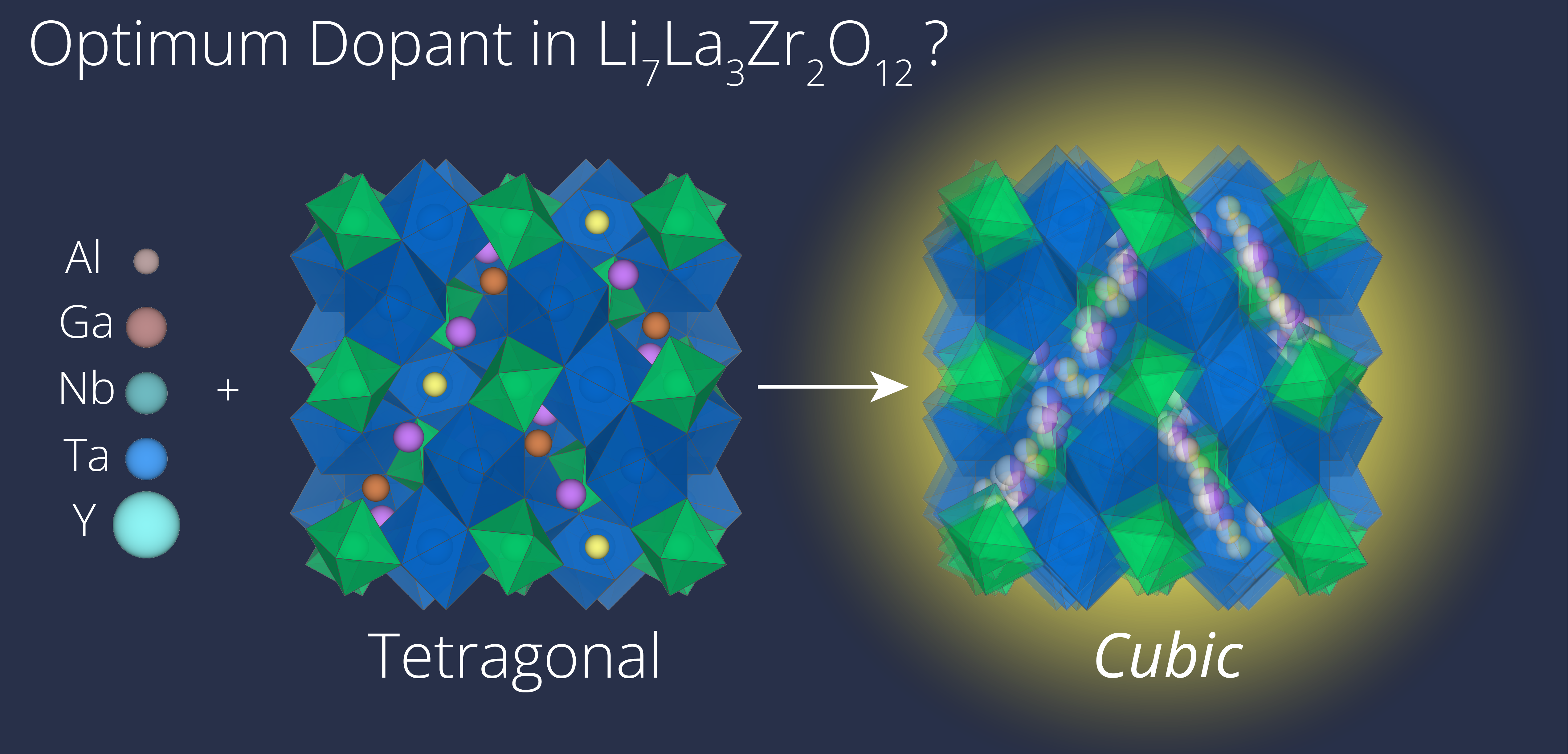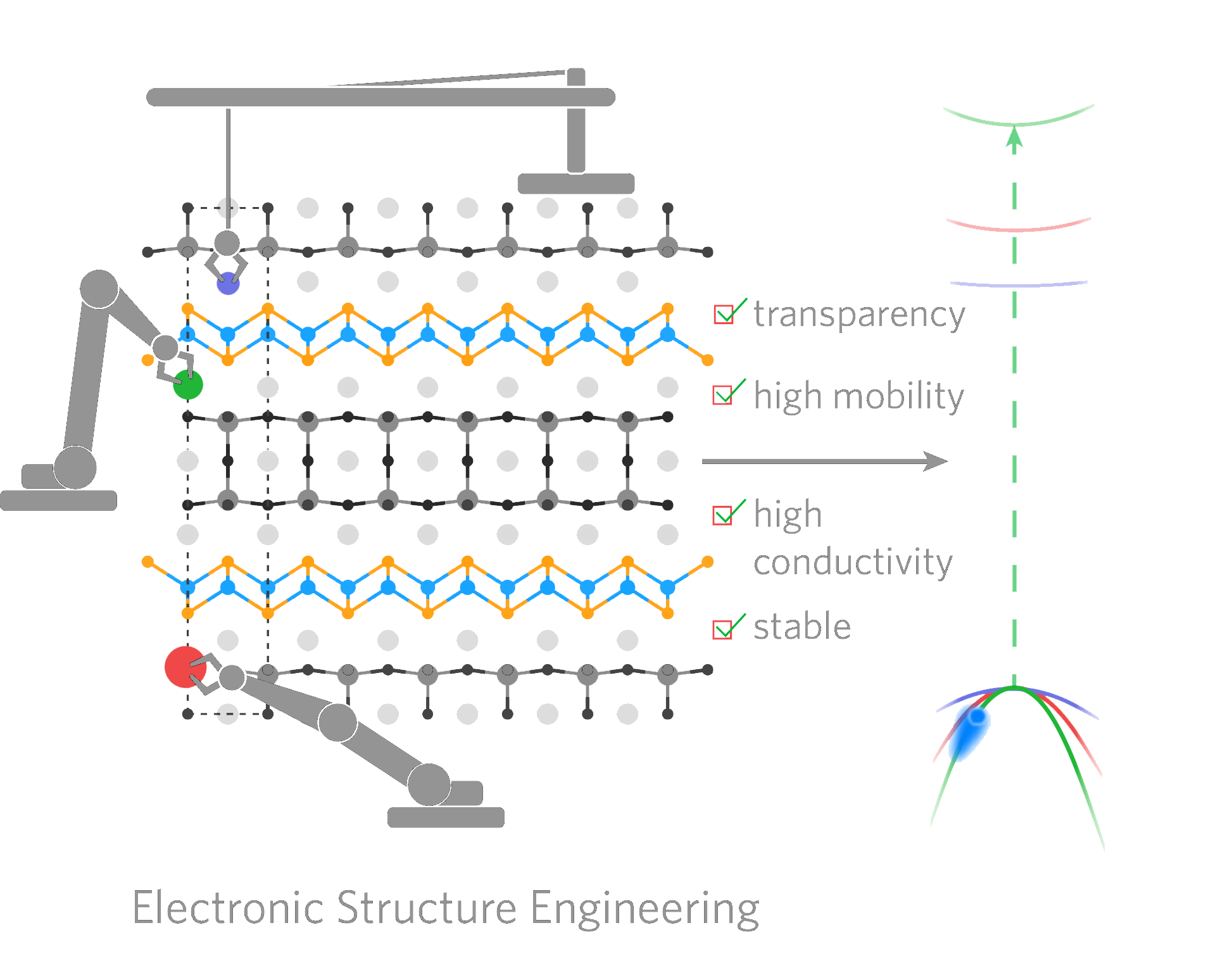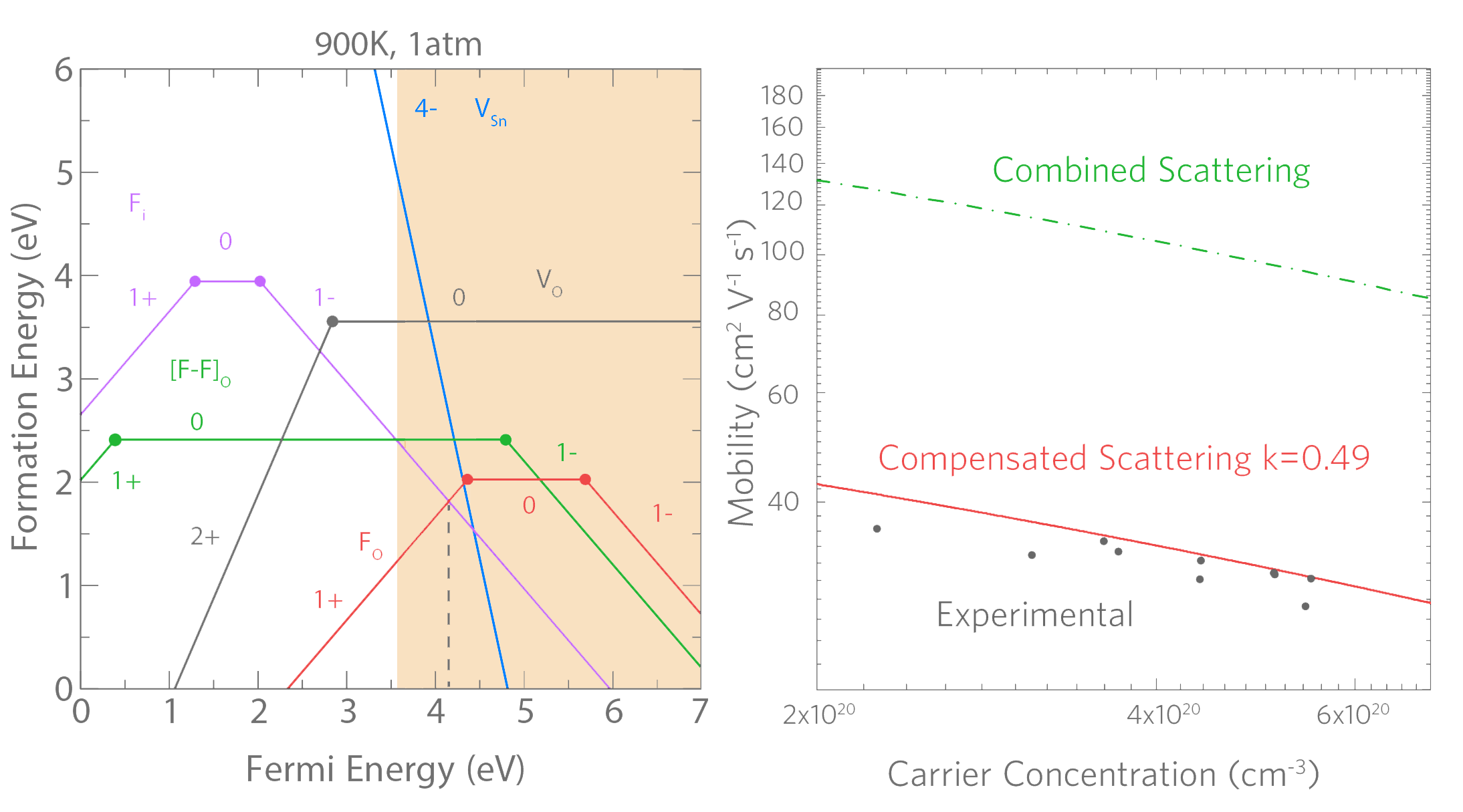Research Highlights
Pseudo-Lithium Vacancies in Hydrogen Rich Li3OCl?
tags: solid state batteries, defects and doping, ionic conductivity, Hydrogen

The antiperovskite Li3OCl is reported as a superionic conductor, however, reproducibility has been poor due to its hygroscopic nature, suggesting that reports are in fact on Li3−xOHxCl. Most experimental and computational studies in the literature focus on pure Li3OCl however, and do not take into account the role of hydrogen in the material. In this work we developed a full defect model of H-doped Li3OCl, showing that the nominal Schottky disorder diminishes with hydrogen incorporation. Additionally, H helps to facilitate Li-ion mobility in Li3OCl by firstly introducing rotatable OH species as well as forming HLi which relaxes off site to form what we define as a “pseudo-VLi” enhancing the ionic conductivity in line with experimentally observed values. Intentional hydrogen doping of hygroscopic materials constitute an underexplored strategy for enhancing ionic transport properties.
J. Mater. Chem. A. , 2025 – DOI: 10.1039/D4TA08352K
Doping Implications of Li Solid State Electrolyte Li7La3Zr2O12?
tags: solid state batteries, defects and doping, ionic conductivity

Solid-state electrolytes, like Li7La3Zr2O12 (LLZO), can enable safer, more energy dense and longer lasting batteries. In this paper we investigated the effect of doping in LLZO with Al, Ga, Nb, Ta, and Y by hybrid density functional theory calculations and a full defect model. The site preferences of Al, Ga, Nb, and Ta result in donor defects that favour more Li vacancies and thus a more disordered Li substructure. This also implies stabilisation of the more ionic conducting cubic phase at the expense of the tetragonal, as seen experimentally. In addition, these calculations indicate that the effect of the dopants on the sintering process is even more important than the ability to induce more ionic charge carriers. Differences in Li vacancy formation energies also suggest a new possible explanation for the two orders of magnitude increase in ionic conductivity upon stabilising the cubic phase.
J. Mater. Chem. A. , 2024 – DOI: 10.1039/D4A01487A
Computationally Driven Discovery of Layered Quinary Oxychalcogenides: Potential p-Type Transparent Conductors?
tags: p-type TCO, photocatalyst, materials prediction

Continuing the search for a high mobility transparent p-type semiconductor to complement the flagship n-type TCOs (e.g. In2O3, SnO2, ZnO or BaSnO3) can be found by exploring more complex materials and utilising established design principles. In this work the layered oxychalcogenide, (Cu2S2)(Sr3Sc2O5), a transparent (Eg > 3.1eV) semiconductor with high reported hole mobilities (~150 cm2 V-1 s-1) was used as a parent compound for this analysis. Using chemical intuition for designer cation choice in the perovskite-like layer (Sr3Sc2O5) we screened 24 variants of this structure type using high throughput density functional theory. From this analysis, our calculations uncovered 9 new thermodynamically stable semiconductors with applications ranging from transparent conductors to photovoltaics. Our predictions have been validated by experimental synthesis carried out by the group of Dr Geoff Hyett (University of Southampton) of a new p-type transparent conductor (TC), with a conductivity superior to all known p-type TCs.
Matter, Cell Press 2020 – DOI: 10.1016/j.matt.2020.05.020
Preview: assetsThe Holey Grail of Transparent Electronics" Aron Walsh and Ji-Sang Park
Matter, Cell Press – DOI: 10.1016/j.matt.2020.08.008
Follow up work by Dr G. Limburn et al. shows the versatility and tunability of these materials focussing on Ba3Sc2-xInxO5Cu2S2 and Ba3In2O5Cu2S2-ySey for photocatalysis applications.
J. Mater. Chem. A 2020 – DOI: 10.1039/D0TA06629J
Resonant Ta Doping for Enhanced Mobility in Transparent Conducting SnO2
tags: n-type TCO, electronic mobility, doping

Building on the dopant design principles shown previously in our Mo-doped In2O3 work we show that Ta is the optimum dopant for SnO2. We show that Ta is a low formation energy resonant electron donor with a lack of dopant hybridisation at the conduction band minimum (CBM) unlike in Sb-doped SnO2 (ATO) or F-doped SnO2 (FTO). Thin films of Ta-doped SnO2 (TaTO) were also fabricated using aerosol-assisted chemical vapour deposition (AACVD), which, combined with high resolution photoelectron spectroscopy and semiconductor statistics modelling show an enhanced mobility compared to ATO and FTO, thus proving that the theory holds for other ns0 semiconductors where the CBM is dominated by metal s states. This work was a close collaboration with Prof. Tim Veal and others at the University of Liverpool as well as with scientists at University College London, Diamond Light source and Pilkington NSG Group.
Chemistry of Materials, 2020 32 (5), 1964-1973 – DOI: 10.1021/acs.chemmater.9b04845
This work was featured on the front cover
Resonant Doping for High Mobility Transparent Conductors: the Case of Mo-doped In2O3
tags: n-type TCO, electronic mobility, doping

This work focusses on developing higher mobility thin films of In2O3 through dopant design. Mo-doped In2O3 (IMO) thin films consistently displays higher mobilities (and thus conductivity) to the industry standard, Sn-doped In2O3 (ITO). Through a mix of theory and spectroscopic methods we show that this is due to the lack of hybridisation of Mo dopant states with the host conduction band minimum (CMB). Unlike in ITO where this occurs, this means that there is no perturbation of the band curvature and effective mass of electrons in In2O3 at the CBM. This understanding means that IMO thin films can achieve the same performance as ITO thin films at half the thickness resulting in a cheaper electronics and new directions for transparent conductors. This work is primarily in collaboration with Prof. Tim Veal and others at the University of Liverpool as well as with scientists at University College London, Binghamton University, Diamond Light source and Pilkington NSG Group.
Materials Horizons, 2020, 7, 236-243 – DOI: 10.1039/C9MH01014A
Dispelling the Myth of Passivated Codoping in TiO2
tags: photocatalyst, doping

Modifying TiO2 to enhance its visible light activity for photocatalytic performance has become a key research goal for materials scientists in the past two decades. Attempts at achieving this have come from extrinsic doping with acceptors such as nitrogen in order to reduce the band gap and promote visible light absorption. In reality however, nitrogen doping results in localised acceptor states above the valence band maximum and cause detrimental trap states and recombination centres. A popular approach to alleviate this problem was to passivate the acceptor states by codoping with a donor dopant. Using the archetypal codoping pairs of [Nb+N] and [Ta+N]-doped anatase we show that passivated codoping is not achievable in TiO2 using hybrid density functional theory. This work shows indicate that the natural defect chemistry of the host system (in this case n-type anatase TiO2) is dominant, and so concentration parity of dopant types is not achievable under any thermodynamic growth conditions.
Chemistry of Materials, 2019, 31 (7), pp 2577–2589 – DOI: 10.1021/acs.chemmater.9b00257
Self-Compensation in Transparent Conducting F-doped SnO2
tags: n-type TCO, doping

The conductivity and mobility limits in fluorine-doped tin dioxide (FTO) are investigated using a combination of atmospheric pressure chemical vapor deposition (APCVD) and hybrid functional density functional theory (DFT). FTO is a widely used low-emissivity glass coating as well as a transparent conductive layer in photovoltaic cells. Modelling of the transport properties shows that the measured Hall effect mobilities are well below the theoretical ionised impurity scattering limit. Calculation of the dopant and intrinsic defects within FTO show that a self-compensation mechanism occurs whereby interstitial Fluorine (Fi) acts as an acceptor compensating substitutional fluorine (Fo). This work highlights the complex nature of dopants and defect in well characterised metal oxides, providing insight into the possible disadvantages to conventional doping. This work was in collaboration with the group of Prof. Tim Veal (University of Liverpool) and Pilkington NSG group.
Advanced Functional Materials, 2018, 28, 1701900 – DOI: 10.1002/adfm.201701900
Engineering Valence band Dispersion for High Mobility p-type Transparent Conductors
tags: p-type TCO

The lack of a high-mobility, high conductivity, p-type dopable transparent conductor has been a stumbling block for the electronics industry for decades. This hinders the development of transparent p-n junctions as well as improving on the efficiency of applications such as photovoltaics. This work furthers the design principles set about in copper-based oxides and chalcogenides extending them to the pnictides, in particular, the family of compounds with the MCuP formula (where M = Mg, Ca, Sr and Ba). Here the combination of Cu 3d and P 3p mixing at the top of the valence band twinned with a trigonal planar coordination gives rise to a highly dispersive valence band maximum (VBM) with a low ionisation potential ideal for high hole mobility dopability. Experimental undoped powders of CaCuP were synthesised as a proof of concept displaying high p-type conductivity. This work helps forward the field of transparent conductors and also shows that CaCuP is a material with the potential for enhancing applications which need a high hole mobility p-type component. This work was incollaboration with the group of Prof. Robert Palgrave (University College London).
Chemistry of Materials, 2017, 29 (6), pp 2402–2413 – DOI: 10.1021/acs.chemmater.6b03306
Part of the special issue assetsComputational Design of Functional Materials" with work featured on the front cover
A full list of publications can be found on both Google Scholar and my CV